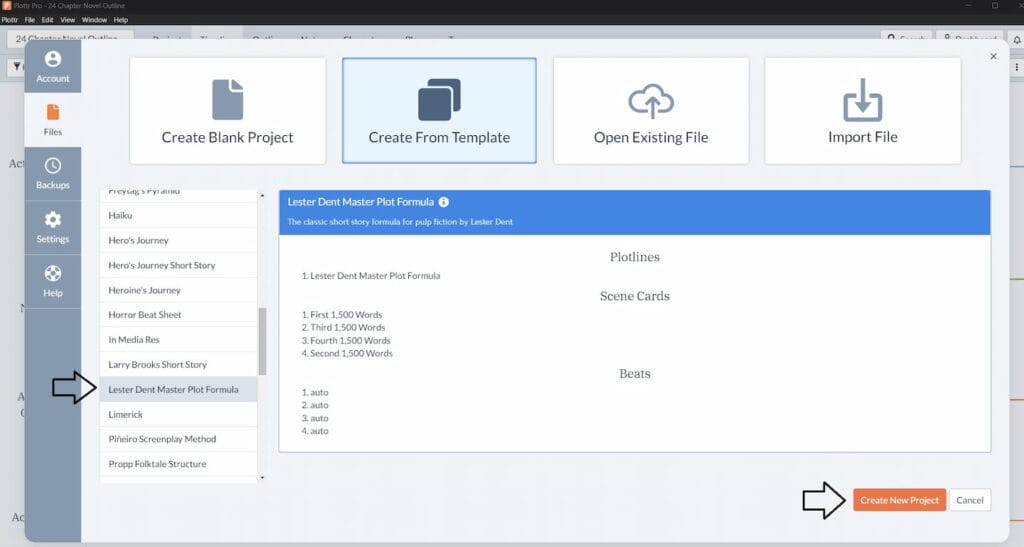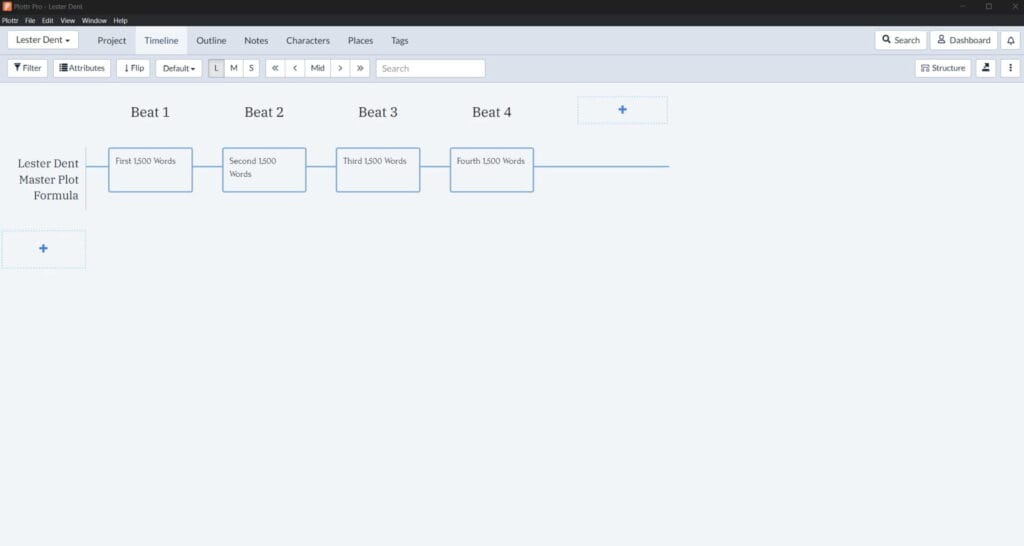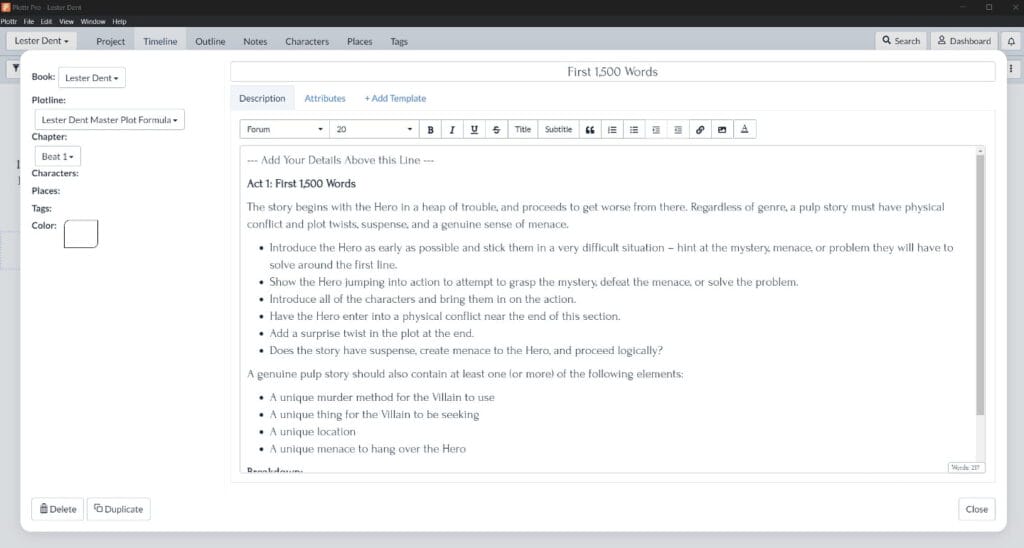Pull on your fedoras, don your trench coats, and prepare to dive into a universe filled with unpredictable plot twists. Plottr’s Lester Dent Master Plot Formula template will help you explore the thrilling and dangerous world of pulp fiction.
What is the Lester Dent Master Plot Formula?
The Lester Dent Master Plot Formula, also known as the “Pulp Fiction Formula,” is a time-tested structure created by pulp fiction author Lester Dent, who is best known for the Doc Savage series.
Dent believed that a good story should be fast-paced and action-packed, with plenty of excitement and suspense. He recommended writers use short paragraphs and sentences and avoid excessive description or introspection.
Many writers of popular fiction have used the Lester Dent Master Plot Formula. Ian Fleming (creator of James Bond) credited Dent’s formula with inspiring his own writing. This is one of multiple pulp fiction templates available in Plottr.
The Template for Plotters, Pantsers, and Especially Pulpsters
If your heart races at the thought of action-packed adventure stories, noir mysteries, and relentless thrills, the Lester Dent Master Plot Formula might be for you.
This method is perfect for writers who love fast-paced, high-stakes narratives that keep readers on the edge of their seats.
The Dent Formula is ideal for you if you want to write pulp fiction, noir, action adventure, and suspense tales. Whether you’re a pantser, a plotter, or somewhere in between, this template will help you craft an unforgettable journey for your characters and readers.
Pulse-Pounding Plot Points in the Lester Dent Formula
The Lester Dent plot formula breaks the story down into four equal parts, each accounting for 25% of the story. For a 6,000-word story, each section would consist of 1,500 words. If you’re writing a 60,000-word novel, you’d allocate 15,000 words for each section.
Act 1: The Setup
First, introduce your hero, who is quickly swept up into an action sequence. In this first act, your hero tries to solve the mystery or defeat a menace but fails. There’s always a twist at the end of each act, and the first twist is usually a low point in the story.
Example: In the opening of Suzanne Collins’ The Hunger Games, we are introduced to Katniss, the protagonist, who is already in trouble as she volunteers to take her younger sister’s place in the Hunger Games. Throughout this first act, she attempts to unravel the puzzle of how to survive the Games and outwit the other tributes, but ultimately fails— and is left in a dismal state when her friend Rue is killed.
Act 2: Rising Tension
Here the tension rises as the story progresses through action and hooks that keep readers engaged. Misleading elements make readers believe the story is moving toward a resolution. But not so fast! At the end of Act Two, it becomes apparent that the protagonist’s efforts are floundering.
Example: In Dan Brown’s The Da Vinci Code, Robert Langdon is on a quest to uncover the truth about the Holy Grail. As the story progresses, the tension rises with each clue Langdon uncovers and each obstacle he faces. There are misleading elements that make the reader believe the story is moving toward a resolution, but in the end, it becomes apparent that Langdon’s efforts are falling flat.
Act 3: Glimmer of Hope
This act opens with a glimmer of hope as the protagonist makes progress, only for the story to take a downward turn toward its darkest moment. At the end of Act Three, your protagonist should find themselves in a hopeless situation, with everything they have tried failing to resolve the problem and possibly making matters worse.
Example: In Tolkien’s The Lord of the Rings, Frodo and his companions have been on a quest to destroy the One Ring. In Act Three, they finally reach the goal of destroying it, but it comes at a great cost, with Frodo and Sam stranded in the heart of Mordor with no clear way of escape. It’s a glimmer of hope that they have succeeded in their mission, but their situation is still dire.
Act 4: The Climax and Resolution
In the last act, readers should see your hero work towards a satisfactory ending, though not necessarily a happy one. All the action planted throughout the story comes together, culminating in a final surprise twist. In pulp fiction, the tension continues until the very last line.
Example: In Gillian Flynn’s Gone Girl, authorities accuse Nick of murdering his wife Amy, who has disappeared. Throughout the story, the tension continues to build as Nick tries to clear his name and find his wife. In the climax, the truth about Amy’s disappearance is revealed — but it’s not a happy ending for Nick, as he realizes he’s trapped in his marriage with a manipulative and dangerous woman. The tension continues until the very last line, leaving the reader with a sense of unease.
How to Use the Dent Pulp Formula in Plottr
Using the Lester Dent Master Plot Formula in Plottr is simple and effective. Just follow the template’s structure, adding your unique story elements, twists, and turns to each act. If you don’t yet have Plottr, you can see pricing here, or you can get started for free with a 30-day trial.
These are the steps to use this plot template:
- Step 1: In the Files tab in the Plottr dashboard, click Create From Template

- Step 2: In the list of templates that appears, click Lester Dent Master Plot Formula, then Create New Project

- Step 3: Give your project a name so you can find it easily later. The template will open in the Timeline screen

- Step 4: Click on any of the beats’ scene cards to start adding your ideas (you can leave in the beat guidelines and write above them or replace them)

Plot templates in Plottr play well together, whether you’re writing pulp fiction or feel-good romance. Try these other templates if you’d like to add a subplot or secondary plotline:
Make a Dent in Your Story Idea
Now unleash your inner pulp hero or heroine. Check out the Lester Dent Master Plot Formula Template in Plottr with a free trial, and share your thoughts in the comments below.







Comments